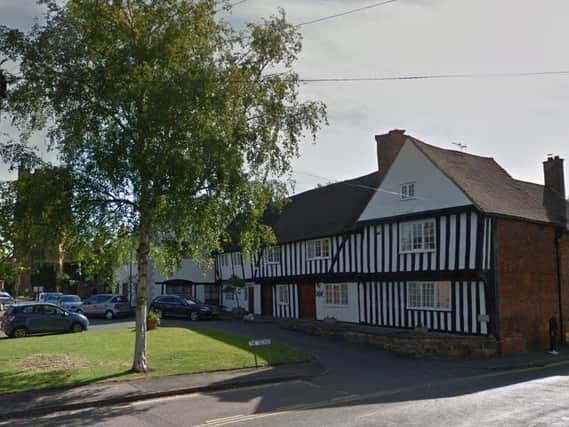Former Advertiser reporter reveals our area's fascinating links with the Gunpowder Plot


One of the happiest memories of my childhood was the gradual lead-up to the annual November 5 bonfire night festivities.
For weeks beforehand, my sister and I would have collected any spare wood that was lying around, carefully placing it on an ever-growing pile on the newly-vacated potato patch in our large garden in Churchover.
Advertisement
Hide AdAdvertisement
Hide AdDead timber of all shapes and sizes would be commandeered from spinney and hedgerow, tied together, and hauled back to base.
Then there was the making of the ‘Guy’ himself. The torso would be a stuffed hessian sack, the arms and legs made from old pairs of trousers filled with newspaper, and lastly there was the head.
Ah, the head. This definitely called for the skills of seamstress, so a suitable candidate – almost certainly my sister - would be employed to sew on the eyes, ears, nose, mouth and last, but by no means least, a dastardly looking black moustache and beard.
Our newly completed Guy would then be placed in an old pram and pushed around the village, where anyone passing might be accosted and asked if they had ‘a penny for the Guy’.
Advertisement
Hide AdAdvertisement
Hide AdSadly this tradition seems to have virtually died out, undoubtedly replaced by the now universal celebration of Halloween.
Bonfire Night itself was fabulous fun, with many of the neighbours coming round to enjoy the festivities. The fireworks would be let off, and afterwards, everyone feasted on spuds in their jackets, dripping with what might now be regarded as far too much butter and salt.
Mind you, back then, I had no idea that Rugby and surrounding area was very much involved in the Gunpowder Plot of November, 1605… and in particular the village of Dunchurch.
The facts of the conspiracy are fairly well known. There were 13 conspirators – a rather ominous number, perhaps – and the plotters were all Catholics determined to do something about the discrimination and persecution being suffered by adherents to their faith.
Advertisement
Hide AdAdvertisement
Hide AdApart from two men, a servant by the name of Thomas Bates and Guy Fawkes, a soldier mercenary, the plotters were all Midlands gentlemen of means.
The plot to blow up the Houses of Parliament was doomed from the start, and it’s almost certain that the authorities knew something was afoot, hence the search of the cellars which uncovered the hapless Fawkes.
So. The plan was to kill King James and his parliament, start an insurrection and place on the throne the monarch’s daughter, Princess Elizabeth, who was residing at Coombe Abbey, near Coventry.
On Monday, November 4, 1605, plotter Sir Everard Digby and seven servants were installed at the Red Lion inn, Dunchurch, near Dunsmore Heath, masquerading as a ‘hunting party’.
Advertisement
Hide AdAdvertisement
Hide AdThe reason Dunchurch was chosen was because of its proximity to Coombe Abbey, where the princess was lodged. The plan was to kidnap her once the deed had been done, and make her queen.
She would, it was hoped, eventually marry a Catholic prince, and the future would improve for Catholics.
The plotters were led by Robert or ‘Robin’ Catesby, who had been born in Lapworth, near Warwick, but who now lived in the family home at Ashby St Ledgers, just over the border in Northamptonshire.
As the party enjoyed a convivial supper at the Red Lion, fellow conspirators John Wintour and John Grant travelled from Rugby to join them, and then waited to hear news of the plot.
Advertisement
Hide AdAdvertisement
Hide AdWell, we all know it didn’t end well. The plot failed, Fawkes was captured, and the rest of the conspirators fled across Dunsmore Heath, eventually ending up at Holbeach House in Staffordshire.
The Worcestershire Militia laid siege to the house, there was a fire fight, and several of the plotters, including Robert Catesby were killed. The rest were captured.
Following their trial, the survivors endured the horrific deaths meted out to traitors in those days – hanging, drawing and quartering. Their heads and limbs were impaled on spikes in public view, to serve as a warning of the awful penalties imposed for treason.
The Red Lion at Dunchurch is now a private residence, known as Guy Fawkes House, although the man himself never visited. He had been captured and held prisoner in the Tower of London, about to suffer the appalling torture of the rack and manacles.
Advertisement
Hide AdAdvertisement
Hide AdThe story of the Gunpowder Plot continues to fascinate, for any number of reasons, and particularly so because of its Midlands links. From Rugby, the trail of the conspiracy led across Warwickshire and into the neighbouring county of Worcestershire, and then finally to its conclusion in the bloodstained grounds of Holbeach House in Staffordshire.
It’s just a pity that, as a boy growing up only a few miles from where so much of the action took place, I had no knowledge of my home turf’s links to the story.
For that would certainly have added an extra bit of spice as we chewed on those over-buttered and exceedingly salted potatoes while we huddled around the dying embers of that Churchover fireworks night of so long ago.
John Phillpott’s memoir of his time as a reporter on the Rugby Advertiser during the 1960s titled Go and Make the Tea, Boy! was published during the summer.